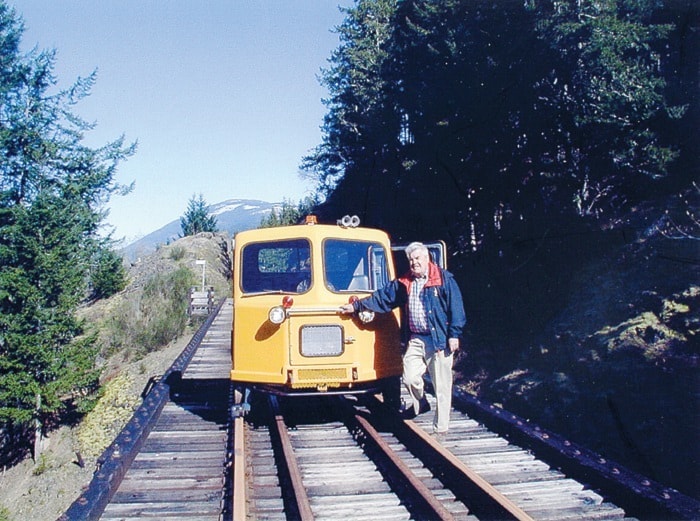PART II
Bob Daines made his living running logging trucks, but the sound of the clickity-clack is what really make his heart sing. “I’m a train buff...my first love has always been the railroad,” says Daines. His office is filled with photographs of old logging camps that no longer exist, early-era logging trucks which you might see now in a museum, and logging railroad operations that have been reclaimed by the bush. Well, almost all. There’s still one active logging railroad in all of North America, and that’s based out of Woss. It was here, a few weeks back, when Daines joined up with other railroad enthusiasts to have the time of their lives. On that weekend, the members of the North American Railcar Operators Association were provided with clear tracks to run their speeders through the mountain valleys. “It’s a lot of fun,” he says, barely concealing his enthusiasm. Born in 1938, the year of the big fire, Daines was raised in Camp 4, located just north of Campbell River. Then, in 1943, his dad and mom, Robert and Kit, relocated to Camp 5. A year later, on Daines’ birthday, his sister was born. It was in the camps where Daines was introduced to the Gibson Speeders, small and large self-propelled railway cars that zipped the men back and forth from logging operations. The Speeders also brought father and son together as Daines would travel in the cars with his dad. “Sometimes it was the only chance to see him and sometimes I got to drive,” he recalls with a warm smile. But with the advent of new road building equipment, improved engines and brakes, the logging railroads vanished and were replaced with logging trucks. By 1957, Daines was already working in the logging industry when he jumped at the opportunity to drive trucks. After a couple of years, he went to work for Bill Neil who had his own logging truck business. When Neil got a contract to haul logs out of Beaver Cove, Daines worked there on one-month shifts. “I got stuck, no one else wanted to go,” he says. Daines worked for Neil until 1961 when his boss gave up the contract at Beaver Cove. With no one else to turn to, the manager asked Daines to take over the contract. So Daines sold his car, had his dad co-sign a loan and purchased his first logging truck. Despite the long days, and the longer nights “monkey-wrenching,” things were going well and were about to become even better. He relocated to the booming town of Kitimat where logging was a 24/7 job, 12 months a year. “It was the best thing I ever did,” he says. After 10 years in Kitimat, it was time to relocate again. With his wife Jeanette (they married in 1965) and two children, the family moved back to Vancouver Island and the relatively new community of Gold River. They stayed until 1997, when Daines sold his logging truck business and became semi-retired. And with the long hours of working out of the way, Daines was ready to rekindle his passion for the railway. He spotted an old, smashed-up Speeder in a “boneyard” but decided it was a good investment for $400. He redid the fiberglass, rebuilt the engine and finally he had a Speeder of his own that tops out at almost 40 mph. “It’s a lot of fun and it gives me something to do,” he says. “There’s events all across North America and this weekend 14 of us are heading to Woss.”
